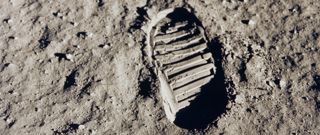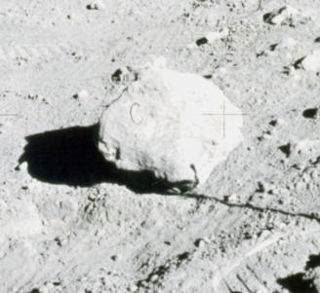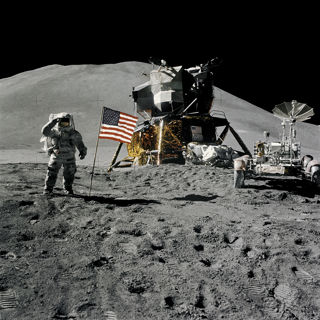
How Do We Know The Moon Landing Really Happened?
- 15th Jun 2017
- Author: Scott Davis
Mankind first stepped foot on the Moon on 20 July 1969, achieving what is arguably humanity’s greatest ever feat of exploration. For two and a half hours, Neil Armstrong and Buzz Aldrin explored the lunar surface on foot while Michael Collins piloted the Apollo 11 orbiter around the Moon. That’s the history that we continue to celebrate today, 50 years on from the first landing.

Many of us either remember watching the landing ourselves or have heard the memories from our parents and grandparents. But what do you say when someone insists that the Moon landings never really happened?
In this blog, we dig into some of the common questions around the Moon landings, and address the more curious lunar phenomena with the latest data and scientific understanding.
A vast weight of evidence supports the fact that humans really did land on the Moon multiple times between 1969 and 1972. But it is important to question and think critically about events of this scale – and sometimes researching and puzzling out the answers can be half the fun!
Wouldn’t the Van Allen belts have fried the astronauts?
One of the most popular theories as to why the Moon landings couldn’t have happened has to do with something called the Van Allen belts. These are two huge belts of radiation that surround the Earth, shaped by the Earth’s magnetic field and pounded with high-energy particles from the Sun’s wind. It’s been claimed that humans couldn’t have passed through these belts without being fried with lethal doses of radiation.
In fact, the international scientific community was aware of the Van Allen belts thanks to the Explorer, Pioneer, and Luna missions in the 1950s. Luckily, the timings of the Apollo launches were such that the Van Allen belts were at their lowest intensity, which fluctuates with the Sun’s activity.
Radiation sickness occurs when you have been exposed to around 200 to 1000 ‘rads’ of radiation within a few hours. The Apollo 11 crew were within the belts for less than two hours during their journey to the Moon, and so would have only been exposed to an estimated 18 rads – well within the safe limit. There can still be some adverse effects from even this level of radiation, so NASA made sure that the Apollo 11 spacecraft was well-insulated such that the average dose of radiation over the 12-day mission was just 0.18 rads, or similar to the radiation dosage from a chest X-ray.
You can work through all the maths of the estimated radiation levels, along with some helpful answers, in this NASA Education worksheet here.
For more information see this excellent blog from Vintage Space.
Why did the flag flap on the Moon?
Another ‘giveaway’ that the landing was faked comes from the footage of the American flag that Neil Armstrong and Buzz Aldrin placed on the Moon. From photos and video, it appears to be flapping in the wind. But hold on a minute! There’s no air on the Moon so how can it flutter?! The truth is that the flag isn’t flapping. There is a horizontal rod projecting from the post at the top of the pole to hold the flag unfurled. The flag was disturbed as it was planted into the ground and kept this bent shape because of the lack of strong gravity on the Moon.
In video footage of the flag being planted into the Moon’s surface, it also appears to wave back and forth. This is because when the astronauts were planting it, they rotated it back and forth to better dig into the lunar soil, which of course made the flag ripple as it swung like a pendulum- without a breeze. There’s a huge amount of footage of the flags stood on the Moon in exactly the same position.
And why can’t we see stars in the pictures?
Speaking of the flag photographs, it’s often pointed out that there are no stars to be seen in the background! This is actually a common feature of photographs from space, where the contrast between light and dark is extreme. The surface of the Moon reflects the strong sunlight and appears very bright in photographs. This brightness drowns out the relatively dim light from stars in the dark sky, akin to how car headlights can drown out the fainter light from nearby objects. The human eye can adjust and pick out the stars, but unless it’s set to the right settings, a camera struggles with the contrast. Astronauts on the International Space Station today regularly take photographs of the Earth that show a completely starless background, but it’s the same problem of contrasts at work.
For more information, read this blog from astrophysicist Brian Koberlein or astronaut Tim Peake’s response to this question in his FAQs.
What about those funny shadows?
Let’s talk about the shadows in photographs from the Moon. One of the subtler arguments against the Moon landings has to do with non-parallel shadows.
If the Sun is the only source of light, why do some shadows appear to point in multiple directions? For example, in the picture to the side, the astronaut’s shadow matches up with the lander’s, but there seems to be another shadow from the lander foot pointing towards the astronaut.
There must be additional studio lights to explain this!
Actually, a rough, uneven surface can cause all sorts of shadows at different angles, even with a single light source like the Sun. This something that can be easily experimented with at home.
The combination of the Moon’s rough surface and the long shadows from a Sun low in the sky can easily create complicated shadows.
The funny shadow in the picture above is likely created by an uneven ridge that extends towards the astronaut and a low-angle Sun. You can watch the MythBusters gang try this out, and explore many other Moon landing myths, in their NASA Moon Landing episode.

The rock prop labelled with a 'C'
The infamous labelled rock from the Apollo 16 mission. Movie props are often numbered and lettered so that stagehands know where to place them. The theory goes that the rock in the photo to the left is a prop that someone must have accidentally placed facing the wrong way.
But in fact, the label simply isn’t there. The image of the rock is taken from a much larger shot of the Moon’s surface, and if you look at the original image shown in the line up above, the marking isn’t there. Either a small hair or piece of thread must have got caught in the machine while it was being copied.
For more detailed analysis of these pictures, check out this blog link.
Modern proof
There are of course many more arguments against the Moon landings out there. Many of them are addressed on sites like clavius.org, which is a good resource for all things related to Apollo. But the key thing to do when presented with new questions and theories surrounding the Moon landings is to ask questions, think about logical explanations, and do your homework. There are vast swathes of archive material out there about all of NASA’s missions past and present and it can be a fascinating journey.
But we didn’t want to spend all this time addressing Moon landing myths without also discussing some of the more recent, international evidence that proves that humans once did walk on the Moon. The evidence doesn’t just come from NASA.
Here are three modern examples:
-
![Comparison between 3D SELENE landscape (left) and Apollo 15 photo (right).]()
JAXA/NASA Apollo 15 site: past and present
The right half of the image was taken by the Apollo 15 crew in 1971. The left half of the image is a 3D visualisation from several photographs captured by a Japanese lunar orbiter called SELENE in 2008.
The camera on SELENE didn’t have the resolution to capture individual rocks, but the two images are obviously of the same terrain in the same scenery, from lunar missions separated by 37 years and directed by space agencies from two different countries.
SELENE also captured images of the halo of lunar dust created from the Apollo 15 lunar module exhaust. Read more here.
-
![Apollo 17 landing area with labels.]()
NASA We can see the astronauts' footprints!
We can actually see the footprints and spacecraft left behind by the Apollo astronauts.
It is often claimed that if we really landed on the Moon, then it should be fairly easy to see the evidence with a telescope such as Hubble. But as powerful as Hubble is at spying galaxies, it simply doesn’t have the resolution to pick up fine details like spacecraft on the Moon – they’re too small and the Moon is too far away.
Thankfully, we do have a closer spacecraft, NASA’s Lunar Reconnaissance Orbiter, which has been in orbit around the Moon since 2009. And it has captured recent photographs of all the Apollo landing sites (see here and here). These images show the Apollo spacecraft in exactly the right locations and amazingly, you can even see the astronauts’ footprints as they explored their lunar home.
These landing sites have also been independently spotted by a variety of other spacecraft from China, India, and, as discussed above, Japan.
-
![Apollo 17 Moon rock at the National Space Centre.]()
National Space Centre The proof is in the Moon rock
Finally, we have the proof that the Moon landings actually happened right here on Earth, in the form of Moon rocks. In the 382 kilograms of Moon rocks that were brought back by the Apollo crew many glass spherules were found.
Glass spherules are produced in two key ways: explosive volcanic activity and by high-speed meteorite impacts that melt and vaporise rock. In either case, the rock needs time to cool and crystallise slowly. On Earth, the elements quickly break down any volcanically-produced glass. But in space, glass spherules survive nearly pristine, and we’ve found them in both meteorites that have fallen to Earth and in the Moon rocks returned from the Apollo missions, proving that the Apollo crew were indeed space travellers.
When the first rocks were returned from the Apollo 11 mission, samples were given to 135 different countries around the world as a gesture of good will. These rocks have withstood every possible geology test from labs around the world, and these have confirmed they are indeed of lunar origin.
No other space mission has been capable of returning such quantities of rock. The Soviet Union’s uncrewed Luna programme did bring back some rocks in the 1970s, but only a third of one kilogram. These rocks have been shared with international scientists and match the characteristics of the Apollo Moon rocks.

This blog only skims the surface of the vast quantities of scientific evidence past and present that supports the Apollo Moon landings.
We have explored some of the common questions that surround the Moon landings and have presented the arguments, experiments, and evidence that you can explore further.
The Moon landings were a unique, amazing moment in history and we look forward to the moment when humans once again return to the Moon.
Full references / credits:
(Banner image) Footprint on the Moon. Credit: NASA
(1) Buzz Aldrin on the Moon. Credit: NASA
(2) Van Allen radiation belts. Credit: NASA/John Hopkins University Applied Physics Laboratory
(3) Buzz Aldrin beside the U.S. flag during an Apollo 11 moon walk. Credit: NASA
(4) Buzz Aldrin walks on the surface of the Moon near a leg of the Lunar Module. Credit: NASA/JPL-Caltech
(5) Van Allen radiation belts. Credit: NASA/John Hopkins University Applied Physics Laboratory
(6a) Charlie Duke at the Descartes landing site, Apollo 16. Credit: NASA
(6b) Original image of the Apollo 16 foreground rock. Credit: NASA
(6c) An apparent “C” was superimposed over the Apollo 16 foreground rock. Credit: NASA
(7) Apollo 16 Moon rock. Credit: NASA
(8a) Comparison between 3D SELENE landscape (left) and Apollo 15 photo (right). Credit: JAXA/NASA
(8b) Apollo 17 landing area with labels. Credit: NASA
(8c) Apollo 17 Moon rock at the National Space Centre. Credit: © National Space Centre
(9) Apollo 15 Lunar Module Pilot James Irwin salutes the U.S. flag. Credit: NASA










